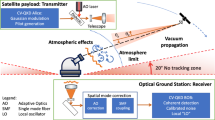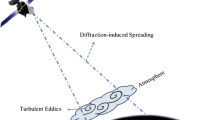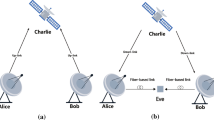Abstract
Continuous-variable quantum key distribution (CVQKD) is aiming at widespread application and adoption in different scenarios, and thus, the application of satellite-to-ground link may play a vital role in establishing the global secure quantum communications. In this paper, we propose an improved tunable CVQKD scheme for the satellite-to-ground free space optical (FSO) link in an orthogonal frequency division multiplexing (OFDM) system. The OFDM-based CVQKD can effectively suppress the random fading effect that resulted from the atmospheric channel since it divides the initial transmission channel into multi-subcarriers working in parallel so as to compensate the weakness of single-channel transmission of the signals. Moreover, the influence of the intensity scintillation, atmospheric transmittance and phase noise caused by atmospheric turbulence is involved in security analysis. The results reveal that satellite-to-ground CVQKD system can reduce the atmosphere influence in an OFDM system. Compared with the single-channel CVQKD in the FSO link, the secret key rate is improved with the OFDM technique within a certain range of subcarrier numbers. Nevertheless, the reduction of symbols per channel cannot make the asymptotic assumption due to the limitation of technology and devices.









Similar content being viewed by others
References
Weedbrook, C., Pirandola, S., García-Patrón, R., Cerf, N.J., Ralph, T.C., Shapiro, J.H.: Gaussian quantum information. Rev. Mod. Phys. 84, 621–669 (2012)
Gisin, N., Thew, R.: Quantum communication. Nat. Photonics 55, 298–303 (2011)
Pirandola, S., Mancini, S., Lloyd, S., Braunstein, S.L.: Continuous variable quantum cryptography using two-way quantum communication. Nat. Phys. 5, 726–730 (2006)
Huang, D., Huang, P., Lin, D., Zeng, G.: Long-distance continuous-variable quantum key distribution by controlling excess noise. Sci. Rep. 6, 19201 (2015)
Shor, P.W., Preskill, J.: Simple proof of security of the bb84 quantum key distribution protocol. Phys. Rev. Lett. 85, 441–444 (2000)
Pomerene, A., Starbuck, A.L., Lentine, A.L., Long, C.M., Derose, C.T., Trotter, D.C.: Silicon photonic transceiver circuit for high-speed polarization-based discrete variable quantum key distribution. Opt. Express 25, 12282 (2017)
Huang, P., He, G., Fang, J., Zeng, G.: Performance improvement of continuous-variable quantum key distribution via photon subtraction. Phys. Rev. A 87, 530–537 (2013)
Fang, J., Huang, P., Zeng, G.: Multichannel parallel continuous-variable quantum key distribution with gaussian modulation. Phys. Rev. A 89, 022315 (2014)
Liao, Q., Guo, Y., Huang, D., Huang, P., Zeng, G.: Long-distance continuous-variable quantum key distribution using non-gaussian state-discrimination detection. New J. Phys. 20, 2 (2017)
Jouguet, P., Kunzjacques, S., Leverrier, A., Grangier, P., Diamanti, E.: Experimental demonstration of continuous-variable quantum key distribution over 80 km of standard telecom fiber. Nat. Photonics 7, 378–381 (2013)
Huang, D., Lin, D., Wang, C., Liu, W., Fang, S., Peng, J.: Continuous-variable quantum key distribution with 1 mbps secure key rate. Opt. Express 23, 17511–17519 (2015)
Vasylyev, D., Semenov, A.A., Vogel, W., Günthner, K., Thurn, A., Bayraktar, O., Marquardt, C.: Free-space quantum links under diverse weather conditions. Phys. Rev. A 96, 043856 (2017)
Liao, S.K., Cai, W.Q., Liu, W.Y., Zhang, L., Li, Y., Ren, J.G.: Satellite-to-ground quantum key distribution. Nature 549, 43 (2017)
Zhang, H., Mao, Y., Huang, D., Li, J.W., Zhang, L., Guo, Y.: Security analysis of orthogonal-frequency-division-multiplexing-based continuous-variable quantum key distribution with imperfect modulation. Phys. Rev. A 97, 052328 (2018)
Wang, Y., Wang, D., Ma, J.: On the performance of coherent ofdm systems in free-space optical communications. IEEE. Photon. J. 7, 1–10 (2015)
Armstrong, J.: OFDM for optical communications. J. Lightw. Technol. 27, 189–204 (2009)
Bahrani, S., Razavi, M., Salehi, J.A.: Orthogonal frequency-division multiplexed quantum key distribution. J. Lightw. Technol. 33, 4687–4698 (2015)
Jin, X.M., Ren, J.G., Yang, B., Yi, Z.H., Zhou, F., Xu, X.F.: Experimental free-space quantum teleportation. Nat. Photonics 4, 376–381 (2010)
Alhabash, A., Andrews, L.C.: New mathematical model for the intensity pdf of a laser beam propagating through turbulent media. Opt. Eng. 40, 1554–1562 (2001)
Bekkali, A., Naila, C.B., Kazaura, K., Wakamori, K., Matsumoto, M.: Transmission analysis of ofdm-based wireless services over turbulent radio-on-fso links modeled by Gamma–Gamma distribution. IEEE. Photon. J. 2, 510–520 (2010)
Bai, F., Su, Y., Sato, T.: Performance analysis of polarization modulated directdetection optical cdma systems over turbulent fso linksmodeled by the gamma-gamma distribution. Photonics 2, 139–155 (2015)
Wang, Y., Wang, D., Ma, J.: Performance analysis of multihop coherent ofdm free-space optical communication systems. Opt. Commun. 376, 35–40 (2016)
Qing, C., Wu, X., Li, X., Zhu, W., Qiao, C., Rao, R.: Use of weather research and forecasting model outputs to obtain near-surface refractive index structure constant over the ocean. Opt. Express 24, 13303 (2016)
Paterson, C.: Atmospheric turbulence and orbital angular momentum of single photons for optical communication. Phys. Rev. Lett. 94, 153901 (2005)
Vasylyev, D.Y., Semenov, A.A., Vogel, W.: Toward global quantum communication: beam wandering preserves nonclassicality. Phys. Rev. Lett. 108, 220501 (2012)
Vasylyev, D., Semenov, A.A., Vogel, W.: Atmospheric quantum channels with weak and strong turbulence. Phys. Rev. Lett. 117, 090501 (2016)
Glauber, R.J.: Coherent and incoherent states of the radiation field. Phys. Rev. 131, 2766 (1963)
Sudarshan, E.C.G.: Equivalence of semiclassical and quantum mechanical descriptions of statistical light beams. Phys Rev. Lett. 10, 277–279 (1963)
Usenko, V.C., Heim, B., Peuntinger, C., Wittmann, C., Marquardt, C., Leuchs, G.: Entanglement of gaussian states and the applicability to quantum key distribution over fading channels. New J. Phys. 14, 93048 (2012)
Gappmair, W., Flohberger, M.: Error performance of coded fso links in turbulent atmosphere modeled by gamma-gamma distributions. IEEE Trans. Wirel. Commun. 8, 2209–2213 (2009)
Xie, G., Wang, F., Dang, A., Guo, H.: A novel polarization-multiplexing system for free-space optical links. IEEE Photon. Technol. Lett. 23, 1484–1486 (2011)
Gyongyosi, L.: Subcarrier domain of multicarrier continuous-variable quantum key distribution. Mathematics 1, 1–25 (2013)
Gyongyosi, L.: Diversity extraction for multicarrier continuous-variable quantum key distribution. In: Signal Processing Conference, pp. 478–482 (2016)
Gyongyosi, L.: Adaptive multicarrier quadrature division modulation for continuous-variable quantum key distribution. In: Proceedings of SPIE, p. 912307 (2014)
García-Patrón, R., Cerf, N.J.: Unconditional optimality of gaussian attacks against continuous-variable quantum key distribution. Phys. Rev. Lett. 97, 190503 (2006)
Navascués, M., Acín, A.: Security bounds for continuous variables quantum key distribution. Phys. Rev. Lett. 94, 020505 (2005)
Pirandola, S., Braunstein, S.L., Lloyd, S.: Characterization of collective gaussian attacks and security of coherent-state quantum cryptography. Phys. Rev. Lett. 101, 200504 (2008)
Guo, Y., Liao, Q., Wang, Y., Huang, D., Huang, P., Zeng, G.: Performance improvement of continuous-variable quantum key distribution with an entangled source in the middle via photon subtraction. Phys. Rev. A 95, 032304 (2017)
Gyongyosi, L.: Distribution statistics and random matrix formalism of multicarrier continuous-variable quantum key distribution. Mathematics 1, 1–47 (2014)
Gyongyosi, L.: Security thresholds of multicarrier continuous-variable quantum key distribution. Mathematics 1, 1–58 (2014)
Gyongyosi, L.: Adaptive multicarrier quadrature division modulation for continuous-variable quantum key distribution. In: Proceedings of SPIE, vol. 9123, pp. 1–37 (2013)
Beland, R.R., Brown, J.H.: A deterministic temperature model for stratospheric optical turbulence. Phys. Scripta. 37, 419–423 (1988)
Berrisford, P., Kallberg, P., Kobayashi, S., Dee, D., Uppala, S., Simmons, A.J.: Atmospheric conservation properties in ERA-Interim. Q. J. R. Meteorol. Soc. 137, 1381–1399 (2011)
Gatto, M.A., Seery, J.B.: Numerical evaluation of the modified bessel functions i, and k. Comput. Math. Appl. 7, 203–209 (1981)
Corless, R.M., Gonnet, G.H., Hare, D.E.G., Jeffrey, D.J., Knuth, D.E.: On the lambert w function. Adv. Comput. Math. 5, 329–359 (1996)
Newman, M.E.J., Barkema, G.T.: Monte carlo methods in statistical physics. Top. Curr. Phys. 46, 252–253 (1999)
Acknowledgements
This work is supported by the Fundamental Research Funds for the Central Universities of Central South University (Grant No. 2018zzts539) and the National Natural Science Foundation of China (Grant Nos. 61379153, 61572529).
Author information
Authors and Affiliations
Corresponding author
Appendices
A The scintillation index analysis
In this appendix, we illustrate the Rytov variance \({\delta }^2_{R}\) in Sect. 2.1. Rytov variance, which is used to estimate the optical fluctuation intensity, can be defined as
where \(k=2 \pi / \lambda \) is the optical wave number, \(H=h_0+Lcos \zeta \) is the satellite altitude, \(h_0\) is the height above ground level, L is the propagation distance, \(\zeta \) is the zenith angle, and \(C_n^2(h)\) is the refraction index structure constant parameter. When \({\delta }^2_{R} < 1\), it indicates the weak turbulence, when \({\delta }^2_{R} \cong 1\), it indicates the medium turbulence, and when \({\delta }^2_{R} > 1\), it indicates the strong turbulence. As for \(C_n^2(h)\), one of the most widely used models is the Hufnagel–Valley (H–V) model described by [42]
where v is the pseudowind in meters per second (m/s) and A is the nominal value of \(C_n^2(0)\) at the ground in \(m^{-2/3}\).
Figure 10 shows \(C_n^2\) in the satellite altitude of 0 km, 5 km, 15 km and 20 km based on the varying wind speed v and constant \(C_n^2(0)\). In the satellite-to-ground scenario, \(C_n^2(0)\) expresses the atmospheric refraction structure above the ocean near-surface. From the weather research and forecasting (WRF) model outputs [23], the near-surface refractive index structure constant is mainly varying in the range of \(10^{-15}{-} 10^{-13}\,\mathrm {m}^{-2/3}\). The wind speed v can be extracted from the ECMWF Re-Analysis (ERA-Interim) data set [43], which ranges roughly from 0 to 25 m/s. We can see clearly that the ocean near-surface turbulence level has little effect above 5 km and the wind speed governs the profile behavior primarily in the vicinity of 10 km. Accordingly, the atmospheric turbulence could be negligible when the altitude is higher than 10 km.
B The atmospheric transmittance analysis
In this appendix, we illustrate the expressions of the above parameters in Sect. 2.2. The transmittance \(T_0\) can be estimated by [12]
\(R(\cdot )\) and \(\lambda (\cdot )\), which are scale and shape functions, respectively,
where \(I_i(\cdot )\) is the modified Bessel function of i-th order [44]. For the given angle \(\chi =\phi -\varphi _0\), the effective spot radius \(W_{\mathrm {eff}}(\cdot )\) can be approximated by
Here, \({\mathscr {W}}(\cdot )\) is the Lambert W function [45].
Based on Eqs. (6), (28)–(31), the probability distribution of the atmospheric transmittance can be evaluated using the Monte Carlo method [46]. In the above model, there are five parameters \((x_0,y_0,W_1,W_2,\phi )\). As shown in Fig. 11, parameter \(\phi \) is uniformly distributed and independent of others. Besides, parameters \((W_1,W_2)\) can be obtained by multiplying large number of small random contributions, which gives a good argument for assuming that \((W_1,W_2)\) is log-normally distributed. Therefore, random parameters \(\varTheta _1={\mathrm {ln}} \frac{W_1}{W_0}\) and \(\varTheta _2={\mathrm {ln}} \frac{W_2}{W_0}\) are introduced to calculate the probability distribution of the atmospheric transmittance, where \(W_0\) is the transmitter beam. The correlation of \((x_0,y_0,\varTheta _1,\varTheta _2)\) could be defined by its covariance matrix, which reads [12, 26]

Combing the results of the scintillation index in Eqs. (26)–(27) with the turbulent regimes, the satellite-to-ground link can be regarded to be affected by weak-to-moderate turbulence (\(\delta _R^2 < 1\)). The elements of \(\varXi \) is expressed by [26]
where \(\varOmega =\frac{kW_0^2}{2L}\) is the Fresnel parameter of the beam and their expectations read
C Crosstalk noise on the subchannels
In this appendix, we illustrate crosstalk noise in Sect. 4. The effect of interchannel crosstalk in the modulation is depicted in Fig. 12. The crosstalk information \(\gamma _i (N_i)\) on the i-th subchannel \(N_i\) is expressed as [34]
where \(0 \le x_j \le 1\), \(\chi (A_j:B_j)=H(B_j)-H(B_j|A_j)\) is the Holevo information of Alice and Bob conveyed by the neighboring subchannel \(N_j\). Since the crosstalk noise \( \gamma _i (N_i)\) on the subchannel \(N_i\) acts for Bob as Gaussian noise, it can be modeled by \( \gamma _i (N_i) \in \mathscr {C} {\mathbb {N}} (0,\sigma ^2_{\gamma _i})\) with variance \(\sigma ^2_{\gamma _i} {\mathbb {E}} [|\gamma _i|^2]\). This additional noise does not change the rate formulas of the system, since this additional noise is already contained in the subchannel’s noise variance \(\sigma _{N_i}^2\) (see Ref. [41], Theorem 2). In other words, the mutual information between Alice and Bob is completely characterized for a given \(N_i\) by the noise variance \(\sigma _{N_i}^2\), which can be decomposed as
where \( \sigma _{E_i}^2 \) is the noise variance of Eve’s optimal Gaussian collective attack. Accordingly, the \(\chi (B:E)\) Holevo information of Eve changes is as follows [34]
Furthermore, crosstalk noise has no effect on the security of the modulation, since it allows no more leaking of information to an eavesdropper than single-carrier CVQKD protocols (see Ref. [34], Theorem 4). Moreover, the influence of excess noise has been analyzed in Ref. [40].
Rights and permissions
About this article
Cite this article
Zhao, W., Liao, Q., Huang, D. et al. Performance analysis of the satellite-to-ground continuous-variable quantum key distribution with orthogonal frequency division multiplexed modulation. Quantum Inf Process 18, 39 (2019). https://doi.org/10.1007/s11128-018-2147-8
Received:
Accepted:
Published:
DOI: https://doi.org/10.1007/s11128-018-2147-8







